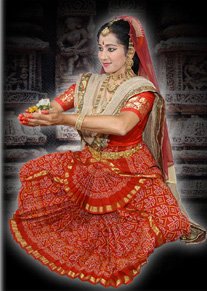
Chaula Devi
- a soothing visual treat
- Shobana
Raj, NY
October 23,
2005
Dance, music
and drama filled the hearts of New Jerseys art lovers, as Shubanjali School
of Performing Arts, carried them into a magical experience for 3 hours
to experience the history behind Chaula Devi, the story of a 14th century
temple dancer of the Somnath temple.
Standing tall
and proclaiming the magnificence and prosperity of Gurjardesh to the world
even today, is the majestic temple of Somnath, believed to have been built
in the 11th century AD. The Somnath temple stands as a symbol of
unity, the urge to protect cultural wealth, the mind to stay free from
foreign invasion and most of all the untiring efforts of connoisseurs of
art and sculpting, to keep the architectural wonder alive, forever.
 One
such lover of art who wrote about the golden Solanki period and its memorable
history was Shri Gaurishankar Joshi, popularly known as Shri Dhoomkethu.
True to his name meaning comet, each of his historical works zoomed through
many hearts and made him a famous writer of Gujarathi literature. One
such lover of art who wrote about the golden Solanki period and its memorable
history was Shri Gaurishankar Joshi, popularly known as Shri Dhoomkethu.
True to his name meaning comet, each of his historical works zoomed through
many hearts and made him a famous writer of Gujarathi literature.
Considered
the best of his works, is the story of a simple temple dancer or devadasi
of the Somnath temple, called Chaula Devi who inspired the King to unite
the land, encouraged art and literature to flourish and fulfilled her dream
of re-building the glorious Somnath temple destroyed by foreign invasion.
Dhinubhai Dave
was inspired to write the screenplay in a theatric form and his dream of
staging this 3 hour huge historical production was successfully met on
the 15th of October at the Union County Arts center, Rahway, New Jersey,
by the Shubanjali school of Performing Arts and its founder-director Suba
Ramesh Parmar who fit the role of Chaula Devi with a vivacity that goes
beyond mere technique.
Under the able
direction of Dinubhai Dave's daughter, the respected educationist Dr. Vandana
Jani, about 800 people were taken on a time machine to witness the glory
of Gujarat, with magnificent stage sets, gorgeous costumes depicting the
royal period, numerous dancers well trained by Suba Parmar and several
aspirants of acting doing an experienced job like professionals.
Be it the lively music by a team of adept musicians or the portrayal of
all nine emotions or navarasas in one scene after another, with love for
the land depicting veera rasa, the King's wrath against his overpowering
minister depicting raudhra, the funny watchman Lundraj contributing to
hasya, the ferocious kapalik bringing beebatsa, the King's love for Chaula
symbolising sringara and so forth, a whole gamut of sentiments with enjoyable
variety satisfied all human senses.
The breathtaking
Angahara dance by Suba Ramesh Parmar and the vibrant tillana in the court
of King Bhimdev and the opening scene depicting the arrival of Devadasis
from the South was spectacular in terms of choreography, costumes and elaborate
stage setup.
This humble
tribute to Dhoomketu will forever stand testimony to the interest in people's
minds even today, to enjoy their historical glory, to cherish their rich
values, to celebrate the freedom to grow culturally and the passion to
re-live such traditional wonders as a guide for posterity. Notwithstanding
the passage of time and the technical developments in this automated, super
fast world, Chaula Devi was a soothing visual treat and last Saturday is
surely a day to remember for many art loving hearts that were brought together!
|

